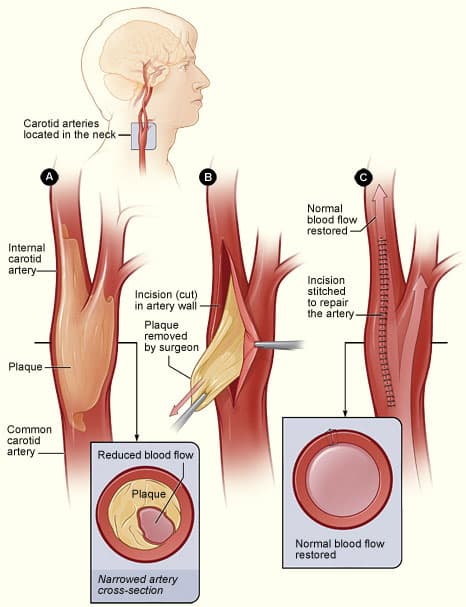This article is for educational purposes only. It should not be used as a template for consenting patients. The person obtaining consent should have clear knowledge of the procedure and the potential risks and complications. Always refer to your local or national guidelines, and the applicable and appropriate law in your jurisdiction governing patient consent.
Overview of Procedure
Carotid endarterectomy is undertaken to prevent ischaemic stroke. The procedure involves an incision along the medial aspect of the sternocleidomastoid muscle, dissection through the platysma, and then along the border of SCM. This reveals the internal jugular vein and carotid artery lying underneath.
The common carotid, internal, and external arteries are slung carefully so as to avoid sending any emboli to the brain. Following clamping of the internal then common then external carotid arteries, a decision regarding shunting will need to be made, depending on collateral circulation to the brain.
A standard endarterectomy whereby the artery is dissected, slung, and clamped where the artery becomes healthy again, with the artery opened longitudinally and the atherosclerotic plaque excised from the arterial media, and closed with bovine patching. Closure of the platysma and skin is undertaken following haemostasis.
Complications
Intraoperative
| Complication | Description of Complication | Potential Ways to Reduce Risk |
| Haemorrhage | This can occur due to damage to either the artery or vein, and may require blood transfusion, although this is very rare in carotid endarterectomy. | |
| Injury to surrounding structures | Nerves in the region (vagus, glossopharyngeal, hypoglossal, mandibular branch of facial, and pre-auricular) can all be damaged. These cause swallowing and speech problems, tongue deviation, drooping corner of mouth, and numb patch of skin around the ear respectively. | When nearing the carotid artery use bipolar diathermy only. |
| Anaesthetic risks | Includes damage to the teeth, throat and larynx, reaction to medications, nausea and vomiting, cardiovascular and respiratory complications. | Forms a part of the anaesthetist assessment before the operation |
Early
| Complication | Description of Complication | Potential Ways to Reduce Risk |
| Pain | The patient will most likely be given a local anaesthetic to minimise pain. | |
| Bleeding | There is a small chance of bleeding and bruising in the wounds post-surgery. In the neck, this may require emergency decompression to save the airway hence is a severe complication if it develops. | |
| Infection | Superficial wound infection is possible, yet graft infections are also possible and are major complication that require life-long antibiotics and graft excision if possible. | Peri-operative antibiotics will reduce the risk of wound and graft infections |
| Scarring | Wounds in the neck generally heal very well, however there will be a scar which can form a keloid scar, particular in high risk ethnicities. | |
| Seroma | A swelling of lymphatic fluid may occur due to disruption of the lymph nodes and channels. | Careful dissection of the lymphatic nodes and channels with ligation will minimise this risk. |
| Blood Clots | DVTs and PEs are a possibility in any operation. The risk is increased in patients with a raised BMI, on the pill, recent flights, previous DVT, pregnancy, smokers, cancer and prolonged bed rest. | The patient will be given anti-embolism stocking and low molecular weight heparin peri-operatively to minimise this risk as deemed appropriate. |
| Stroke | There is an approximately 2% risk of causing a stroke during the procedure, however this risk is less than the lifelong risk of further stroke in patients undergoing this procedure. | |
| MI, kidney failure, and death | Although small, this is always a risk in any major surgery |
Late
| Complication | Description of Complication | Potential Ways to Reduce Risk |
| Reintervention | The reintervention rate for carotid endarterectomy is extremely low. |

